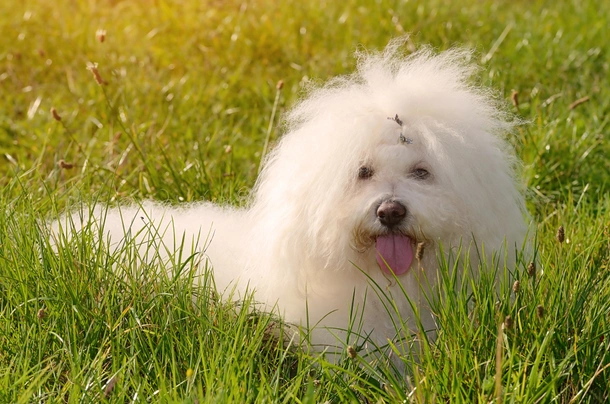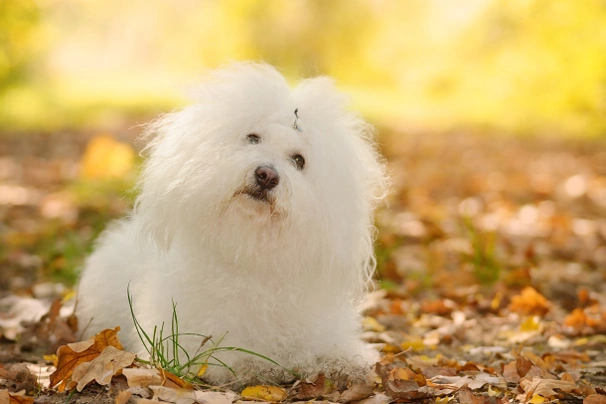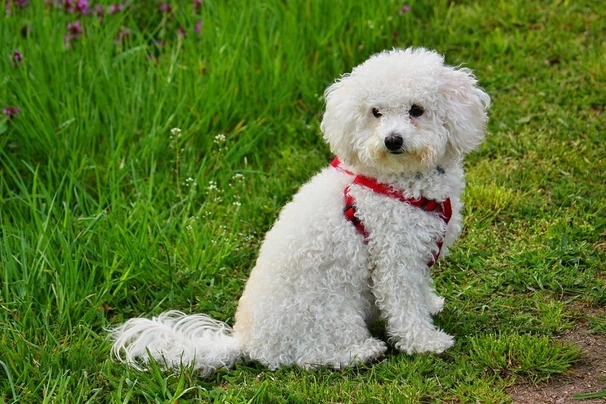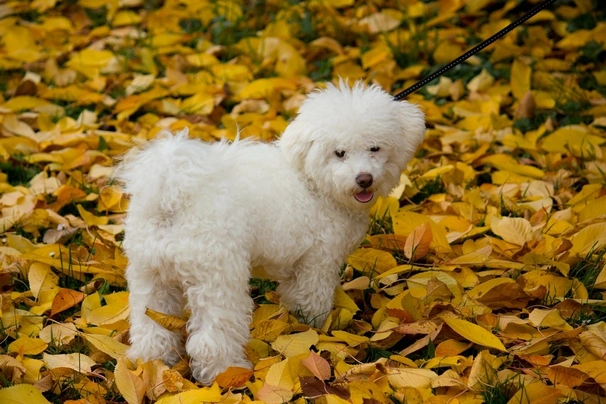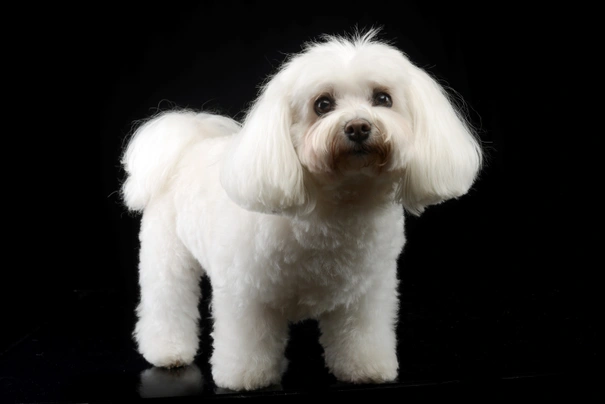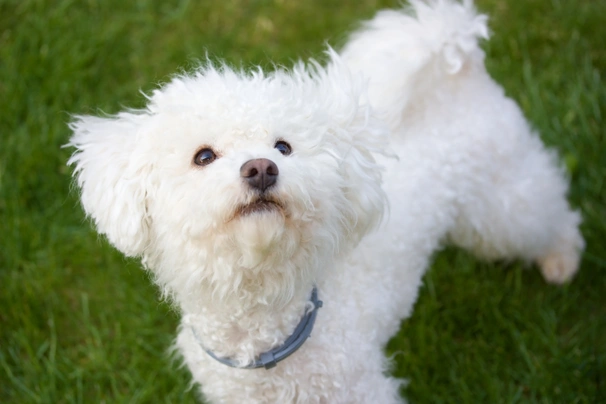Bolognese
Pros
Cons
Introduction of the Bolognese
The Bolognese has become a very popular companion dog thanks to their charming looks their size and the fact these little dogs don't shed thanks to the structure of their flocked coats. The breed originates from northern Italy and is registered with The Kennel Club in the toy group. They are known for their intelligence their loyalty and the fact they are extremely adaptable being just at home living in a big house in the country as they are in a smaller flat in town.
The Bolognese is an energetic dog and as such enjoy being taken out of plenty of interesting walks although they are not overly demanding on the exercise front. They adore being part of a family and being included in everything that goes on in a household although a Bolognese is better suited to households with older children rather than toddlers.
History of the Bolognese
It is thought that the Bolognese is a descendant of the Bichon Frise a breed that hails from Malta and southern Italy. They were given their name having been first bred and developed in Bologna northern Italy and the breed has been around for a very long time first appearing on the scene in 11th and 12th centuries. During the 15th century these little dogs were extremely popular with the Italian nobility when they were kept as companion dogs.
Other dog breeds they are related to include the Lowchen Havanese Coton de Tulear and the Maltese but they are a recognised breed in their own right and one that boasts noble origins. With this said like many older breeds their exact origins remain a bit of a mystery and there is some debate as to whether the Maltese is a descendant or ancestor.
The breed was given their name after the northern Italian city of Bologna which is where it is thought these little dogs may have originated from. It is also thought that the breed has been around since the 1200's. There are images of similar dogs found in Flemish tapestries that date back to the 17th Century and other dogs were painted by the famous artists Titian Goya Watteau and Gosse. Catherine the Great of Russia the Empress Maria Theresa of Austria and Madame de Pompadour owned a Bolognese too.
The Bolognese first arrived in Britain around 200 years ago when they were imported from the Canary Islands by enthusiasts of the breed. However these charming dogs are a rare breed both in their native Italy and elsewhere in the world. Luckily European breeders are now producing Bolognese through careful and selective breeding with an end goal being to increase the numbers of these delightful loyal and affectionate dogs.
Interesting facts about the breed
- Is the Bolognese a vulnerable breed? No they have consistently remained one of the more popular small breeds in the UK thanks to their adorable looks and nice natures
- Catherine Medici was later Queen of France) owned Bolognese
- The breed was popular in royal courts and European noble houses
- The first time the Bolognese was exhibited at Crufts Dog Show was in 2002
Appearance of the Bolognese
Height at the withers: Males 27 - 30 cm Females 25 - 28 cm
Average weight: Males 2.5 - 4 kg Females 2.5 - 5 kg
The Bolognese looks very much like their cousin the Bichon Frise having a lovely distinctive flocked white coat. They are compact little dogs that boast quite a square outline. Their heads are nicely proportioned in relation to their body having a wide skull a distinct stop and a large black nose. Their eyes are round large and dark in colour with nicely pigmented rims. Ears are set high on a dog's head being long and pendulous. The Bolognese carries their ears away from their heads which accentuates its width even more.
These little dogs boast nice level jaws with a perfect scissor bite where their upper teeth neatly overlap their lower ones. Their neck is moderately long and clean with dogs boasting well laid-back shoulders and nice straight front legs. The Bolognese has a compact body with well sprung ribs and deepish brisket. They have level backs and slightly arched loins. Hindquarters are well-muscled and nicely put together. Their feet are oval shaped with dogs boasting black nails and pads. Tails are well feathered and set level with a dog's croup which they carry curved over their backs.
When it comes to their coat the Bolognese boasts a long flocked coat all over their body. However the hair is straight and not curled. These charming little dogs have a pure white coat with no markings whatsoever in it. Their lips nose eyelids and nails are always black in colour. As such the only accepted colour for Kennel Club registration is as follows:
- White
Gait/movement
When a Bolognese moves they do so with an even smart gait never showing any signs of ambling which is highly undesirable. Their legs move in parallel motion at the walk.
Faults
The Kennel Club frowns on any exaggerations or departures from the breed standard and would judge the faults on how much they affect a dog's overall health and wellbeing as well as their ability to perform.
Males should have both testicles fully descended into their scrotums and it is worth noting that a dog can be a little lighter or heavier as well as slightly taller or shorter than set out in the Kennel Club breed standard which is given as a guideline only.
Temperament of the Bolognese
The Bolognese is a charming little dog and one that enjoys nothing more than being included in everything that goes on in a household. They are known to be intelligent loyal fun-loving and affectionate they thrive on human contact and being around people. As such the Bolognese does not like to be left on their own even for shorter periods of time. They are the perfect choice for families where one member of a household stays at home when everyone else is out of the house.
For such small dogs the Bolognese is a calm character and they form very strong bonds with their owners but they tend to be a little wary and reserved when they are around people they don't know. With this said the Bolognese would rarely show any sort of aggressive behaviour towards strangers preferring to keep out of the way. Although a Bolognese will warn an owner when there is a stranger about they are not known to be yappy dogs like many other toy breeds.
Because they are such smart characters the Bolognese needs to be given lots of mental stimulation for them to be truly happy well-rounded characters. Like other dogs if these little dogs are left to their own devices for longer periods of time they can develop all sorts of behavioural issues which includes incessant barking.
Are they a good choice for first time owners?
Bolognese are the perfect choice for first time dog owners because they are so amenable and people-oriented loving nothing more than to please and to entertain their families. They make wonderful companions for older people too because they are not overly demanding on the exercise front.
What about prey drive?
Although very social by nature the Bolognese is always quick off the mark to give chase to anything that moves which means care should always be taken as to where and when a dog can run off the lead. This is especially true if livestock or wild animals are close by.
What about playfulness?
Bolognese have a very playful side to their natures and love to entertain and be entertained. They are known to be a little mischievous at times and are quick to learn what pleases an owner and how to get the best of them when they want something. Dogs remain playful right into their senior years which is just one of the reasons they make such wonderful companions and family pets in households with older children.
What about adaptability?
Bolognese are highly adaptable dogs and providing they are given enough daily physical exercise combined with as much mental stimulation to prevent boredom from setting in they are just as happy living in an apartment in town as they are living in a house in the country.
What about separation anxiety?
Although a Bolognese forms strong ties with their families unlike many other smaller breeds they are not known to suffer from separation anxiety. They do not mind being left on their own providing it is never for too long which could result in a dog developing some unwanted behaviours. This includes incessant barking and being destructive around the home which is a dog's way of keeping themselves amused and to get attention.
What about excessive barking?
Bolognese are known to like the sound of their own voices a little too much which is something that needs to be gently nipped in the bud when a dog is still young being careful not to frighten them which could end up making them bark even more.
Do Bolognese like water?
Some Bolognese like swimming and will take to the water whenever they can more especially when the weather is hot. However if anyone who owns a dog that does not like water should never force them to go in because it would just end up scaring them. With this said care should always be taken when walking a Bolognese off the lead anywhere near more dangerous watercourses just in case a dog decides to leap in and then needs rescuing because they cannot get out of the water on their own.
Are Bolognese good watchdogs?
A Bolognese is a natural watchdog because they are always on the alert and ready to let an owner know when there are strangers about or when something they do not like is going on around them but rarely would they do so aggressively.
Intelligence / Trainability of the Bolognese
The Bolognese is a very clever little dog and because they are always so willing and eager to please in the right hands and with the right amount of training and socialisation these little dogs are pretty easy to train. However they are quite sensitive by nature and as such they do not respond well to any sort of harsher training methods or correction.
They do however answer well to positive reinforcement training and if their education starts as early as possible the Bolognese grows up to be an obedient and very adaptable little dog. The key to successfully training a Bolognese is to be consistent and always fair rewarding good behaviour with a high value treat when first starting a dog's education.
Bolognese puppies are incredibly cute and it is all too easy to spoil them when they first arrive in their new homes. However owners must start out as they mean to go on by laying down rules and boundaries so that a puppy understands what is expected of them. It also helps establish what is acceptable behaviour and what is not which goes a long way in preventing a Bolognese developing "small dog syndrome". This sees them being unruly and wilful making them harder to handle and live with. As such the first commands a puppy should be taught are as follows:
- Come
- Sit
- Stay
- Heel
- Quiet
- Leave it
- Down
- Bed
Children and other
The Bolognese is renowned for being a happy character which is why these little dogs have been so popular for centuries. They are an ideal choice for first time owners as a family pet because they love being around children and thrive on human company liking nothing better than to be involved in all sorts of interactive games.
However as with other breeds any interaction between the kids and their dog should be supervised by an adult to make sure play time does not get too boisterous which ends up in someone getting hurt.
If a Bolognese is well socialised from a young age they are generally very good around other dogs. When it comes to smaller pets and cats if a Bolognese has grown up with them they usually get on well with them although it is best to introduce any new animals slowly and very carefully.
Health of the Bolognese
The average life expectancy of a Bolognese is between 12 and 15 years when properly cared for and fed an appropriate good quality diet to suit their ages.
The Bolognese is a hardy little dog and unlike many other pure breeds they are not plagued by the many hereditary and congenital health issues that many other pedigree dogs suffer from. The health issues that seem to affect the breed the most include
- Hip dysplasia
- Luxating patella - dogs can be tested and scored through the Animal Health Trust
- Eye issues - dogs can be tested through the BVA eye scheme
- Legg-Calves-Perthes disease
- Dental isues
What about vaccinations?
Bolognese puppies would have been given their initial vaccinations before being sold but it is up to their new owners to make sure they have their follow-up shots in a timely manner with the vaccination schedule for puppies being as follows:
- 10 -12 weeks old bearing in mind that a puppy would not have full protection straight away but would be fully protected 2 weeks after they have had their second vaccination
There has been a lot of discussion about the need for dogs to have boosters. As such it's best to talk to a vet before making a final decision on whether a dog should continue to have annual vaccinations which are known as boosters.
What about spaying and neutering?
A lot of vets these days recommend waiting until dogs are slightly older before spaying and neutering them which means they are more mature before undergoing the procedures. As such they advise neutering males and spaying females when they are between the ages of 6 to 9 months old and sometimes even when a dog is 12 months old.
Other vets recommend spaying and neutering dogs when they are 6 months old but never any earlier unless for medical reasons. With this said many breeds are different and it is always advisable to discuss things with a vet and then follow their advice on when a dog should be spayed or neutered.
What about obesity problems?
A Bolognese may gain weight after they have been spayed or neutered and it's important to keep an eye on a dog's waistline just in case they do. If a dog starts to put on weight it's important to adjust their daily calorie intake and to up the amount of exercise they are given. Older dogs too are more prone to gaining weight and again it's essential they be fed and exercised accordingly because obesity can shorten a dog's life by several years. The reason being that it puts a lot of extra strain on a dog's internal organs including the heart which could prove fatal.
What about allergies?
Some Bolognese are prone to suffering from allergies and it's important for a dog to see a vet sooner rather than later if one flares up. Allergies can be notoriously hard to clear up and finding the triggers can be challenging. With this said a vet would be able to make a dog with an allergy more comfortable while they try to find out the triggers which could include the following:
- Certain dog foods that contain a lot of grain and other cereal fillers
- Airborne pollens
- Dust mites
- Environment
- Flea and tick bites
- Chemicals found in everyday household cleaning products
Participating in health schemes
All responsible Bolognese breeders would ensure that their stud dogs are tested for known hereditary and congenital health issues known to affect the breed by using the following schemes:
- Testing for patella luxation - through the Animal Health Trust (AHT)
- Eye testing - through the BVA eye scheme
What about breed specific breeding restrictions?
Apart from the standard breeding restrictions in place for all Kennel Club registered breeds there are no other breed specific breeding restrictions in place for the Bolognese.
What about Assured Breeder Requirements?
There are no Kennel Club Assured Breeder requirements for the Bolognese but prospective owners should discuss any health issues known to affect the breed.
Caring for the Bolognese
As with any other breed a Bolognese needs to be groomed on a regular basis to make sure their coats and skin are kept in top condition. They also need to be given regular daily exercise to ensure they remain fit and healthy. On top of this they need to be fed good quality food that meets all their nutritional needs throughout their lives.
Caring for a Bolognese puppy
Bolognese puppies are boisterous and full of life which means it's essential for homes and gardens to be puppy-proofed well in advance of their arrival. A responsible breeder would have well socialised their puppies which always leads to more outgoing confident and friendly dogs right from the word go. With this said any puppy is going to feel vulnerable when they leave their mother and littermates which must be taken into account. The longer a puppy can remain with their mother the better although it should never be for too long either.
It's best to pick a puppy up when people are going to be around for the first week or so which is the time needed for a puppy to settle in. Puppy-proofing the home and garden means putting away any tools and other implements that a boisterous puppy might injure themselves on. Electric wires and cables must be put out of their reach because puppies love chewing on things. Toxic plants should be removed from flowerbeds and the home too.
Puppies need to sleep a lot to grow and develop as they should which means setting up a quiet area that's not too out of the way means they can retreat to it when they want to nap and it's important not to disturb them when they are sleeping. It's also a good idea to keep "playtime" nice and calm inside the house and to have a more active "playtime" outside in the garden which means puppies quickly learn to be less boisterous when they are inside.
The documentation a breeder provides for a puppy must have all the details of their worming date and the product used as well as the information relating to their microchip. It is essential for puppies to be wormed again keeping to a schedule which is as follows:
- Puppies should be wormed at 6 months old
- They need to be wormed again when they are 8 months old
- Puppies should be wormed when they are 10 months old
- They need to be wormed when they are 12 months old
Things you'll need for your puppy
There are certain items that new owners need to already have in the home prior to bringing a new puppy home. It's often a good idea to restrict how much space a puppy plays in more especially when you can't keep an eye on what they get up to bearing in mind that puppies are often quite boisterous which means investing in puppy gates or a large enough playpen that allows a puppy the room to express themselves while keeping them safe too. The items needed are therefore as follows:
- Good quality puppy or baby gates to fit on doors
- A good well-made playpen that's large enough for a puppy to play in so they can really express themselves as puppies like to do
- Lots of well-made toys which must include good quality chews suitable for puppies to gnaw on bearing in mind that a puppy will start teething anything from when they are 3 to 8 months old
- Good quality feed and water bowls which ideally should be ceramic rather than plastic or metal
- A grooming glove
- A slicker brush or soft bristle brush
- Dog specific toothpaste and a toothbrush
- Scissors with rounded ends
- Nail clippers
- Puppy shampoo and conditioner which must be specifically formulated for use on dogs
- A well-made dog collar or harness
- A couple of strong dog leads
- A well-made dog bed that's not too small or too big
- A well-made dog crate for use in the car and in the home that's large enough for a puppy to move around in
- Baby blankets to put in your puppy's crate and in their beds for when they want to nap or go to sleep at night
Keeping the noise down
All puppies are sensitive to noise including Bolognese puppies. It's important to keep the noise levels down when a new puppy arrives in the home. TVs and music should not be played too loud which could end up stressing a small puppy out.
Keeping vet appointments
As previously mentioned Bolognese puppies would have been given their first vaccinations by the breeders but they must have their follow up shots which is up to their new owners to organise. The vaccination schedule for puppies is as follows:
- 10 -12 weeks old bearing in mind that a puppy would not have full protection straight away but would only be fully protected 2 weeks after they have had their second vaccination
When it comes to boosters it's best to discuss these with a vet because there is a lot of debate about whether a dog really needs them after a certain time. However if a dog ever needed to go into kennels their vaccinations would need to be fully up to date.
What about older Bolognese when they reach their senior years?
Older Bolognese need lots of special care because as they reach their golden years they are more at risk of developing certain health concerns. Physically a dog's muzzle may start to go grey but there will be other noticeable changes too which includes the following:
- Coats become coarser
- A loss of muscle tone
- Bolognese can either become overweight or underweight
- They have reduced strength and stamina
- Older dogs have difficulty regulating their body temperature
- They often develop arthritis
- Immune systems do not work as efficiently as they once did which means dogs are more susceptible to infections
Older dogs change mentally too which means their response time tends to be slower as such they develop the following:
- They respond less to external stimuli due to impaired vision or hearing
- They tend to be a little pickier about their food
- They have a lower pain threshold
- Become intolerant of any change
- Often an older dog can feel disorientated
Living with a Bolognese in their golden years means taking on a few more responsibilities but these are easily managed and should include looking at their diet the amount of exercise they are given how often their dog beds need changing and keeping an eye on the condition of their teeth.
Older Bolognese need to be fed a good quality diet that meets their needs at this stage of their lives all the while keeping a close eye on a dog's weight. A rough feeding guide for older dogs is as follows bearing in mind they should be fed highly digestible food that does not contain any additives:
- Protein content should be anything from 14 – 21%
- Fat content should be less than 10%
- Fibre content should be less than 4%
- Calcium content should be 0.5 – 0.8%
- Phosphorous content should be 0.4 – 0.7%
- Sodium content should be 0.2 – 0.4%
Older Bolognese don't need to be given the same amount of daily exercise as a younger dog but they still need the right amount of physical activity to maintain muscle tone and to prevent a dog from putting on too much weight. All dogs need access to fresh clean water and this is especially true of older dogs when they reach their golden years because they are more at risk of developing kidney disorders.
Grooming of the Bolognese
The Bolognese is high maintenance when it comes to keeping their coats looking good. On the upside these little dogs do not shed thanks to the structure of their flocked coats but they do need to be brushed every day to prevent tangles developing paying particular attention to a dog's stomach their legs and behind their ears where the hair tends to tangle and knot very easily. They also need to be professionally groomed at least twice a year which makes it easier to keep their coats looking good in between visits to a parlour.
It's important to check a dog's ears on a regular basis and if necessary to remove any hairs that grow in their ear canals which is best left up to an expert. If too much hair is left in a dog's ears it means air cannot circulate as it should and this paves the way for an ear infection to take hold which can be really hard to clear up. It's also to check a dog's feet and if there is a lot of hair growing between their pads to carefully trim this away.
Exercise of the Bolognese
The Bolognese might be a small dog but there is nothing they like more than to be taken out for a nice long walk twice a day. With this said a good 30-minute walk twice a day would be ideal and if a dog can run around a back garden as often as possible all the better because it means they can really let off steam. However gardens need to be very secure to prevent dogs from escaping. Because they are so intelligent a Bolognese also needs to be given lots of mental stimulation and they really do enjoy playing lots of interactive games.
Feeding of the Bolognese
If you get a Bolognese puppy from a breeder they would give you a feeding schedule and it's important to stick to the same routine feeding the same puppy food to avoid any tummy upsets. You can change a puppy's diet but this needs to be done very gradually always making sure they don't develop any digestive upsets and if they do it's best to put them back on their original diet and to discuss things with the vet before attempting to change it again.
Older dogs are not known to be fussy or finicky eaters but this does not mean you can feed them a lower quality diet. It's best to feed a mature Bolognese twice a day once in the morning and then again in the evening making sure it's good quality food that meets all their nutritional requirements. It's also important that dogs be given the right amount of exercise so they burn off any excess calories or they might gain too much weight which can lead to all sorts of health issues. Obesity can shorten a dog's life by several years so it's important to keep an eye on their waistline from the word go.
Feeding guide for a Bolognese puppy
Puppies need to be fed a highly nutritious good quality diet for them to develop and grow as they should. As a rough guide a Bolognese puppy can be fed the following amounts every day making sure their meals are evenly spread out throughout the day and it's best to feed them 3 or 4 times a day:
- 2 months old - 66 g to 107 g depending on a puppy's build
- 3 months old - 75 g to 124 g depending on a puppy's build
- 4 months old - 78 g to 130 g depending on a puppy's build
- 5 months old - 78 g to 131 g depending on a puppy's build
- 6 months old - 71 g to 130 g depending on a puppy's build
- 7 months old - 64 g to 118 g depending on a puppy's build
- 8 months old – 56 g to 105 g depending on a puppy’s build
- 9 months old – 56 g to 94 g depending on a puppy’s build
- 10 months old – 55 g to 93 g depending on a puppy’s build
Once a puppy is 11 months old they can be fed adult dog food as shown below.
Feeding guide for an adult Bolognese
Once fully mature an adult Bolognese must be fed a good quality diet to ensure their continued good health. As a rough guide an adult Bolognese can be fed the following amounts every day:
- Dogs weighing 25 kg can be fed 55g to 68g depending on activity
- Dogs weighing 4 kg can be fed 69g to 82g depending on activity
- Dogs weighing 5 kg can be fed 83g to 96g depending on activity
Bolognese price
If you are looking to buy a Bolognese you would need to pay anything from £600 to over £800 for a well-bred pedigree puppy. You may have to accept going on a waiting list because these little dogs can be hard to come by and are considered a rare native breed. The cost of insuring a male 3-year-old Bolognese in northern England would be £20.34 a month for basic cover but for a lifetime policy this would set you back £42.91 a month (quote as of September 2017). When insurance companies calculate a pet's premium they factor in several things which includes where you live in the UK and a dog's age and whether they have been neutered or spayed.
When it comes to food costs you need to buy the best quality food whether wet or dry to feed your dog throughout their lives making sure it suits the different stages of their lives. This would set you back between £30 - £40 a month. On top of this you would need to factor in veterinary costs if you want to share your home with a Bolognese and this includes their initial vaccinations their annual boosters the cost of neutering or spaying your dog when the time is right and then their yearly health checks all of which quickly adds up to over a £800 a year.
As a rough guide the average cost to keep and care for a Bolognese would be between £60 to £90 a month depending on the level of insurance cover you opt to buy for your dog but this does not include the initial cost of buying a well-bred healthy Kennel Club registered pedigree Bolognese puppy.
Buying advice
When visiting and buying any puppy or dog there are many important things to consider and questions to ask of the breeder/seller. You can read our generic puppy/dog advice here which includes making sure you see the puppy with its mother and to verify that the dog has been wormed and microchipped.
Bolognese are among one of the more popular small breeds both in the UK and elsewhere in the world which means that well-bred healthy puppies can often command a lot of money. As such with the Bolognese there is specific advice questions and protocols to follow when buying a puppy which are as follows:
- Beware of online scams and how to avoid them. You may see online and other adverts by scammers showing images of beautiful Bolognesepuppies for sale at very low prices. However the sellers ask buyers for money up front before agreeing to deliver a puppy to a new home. Potential buyers should never buy a puppy unseen and should never pay a deposit or any other money online to a seller. You should always visit the pet at the sellers home to confirm they are genuine and make a note of their address.
- As previously touched upon Bolognese are among the most popular breeds in the UK. As such there are many amateur breeders/people who breed from a dam far too often so they can make a quick profit without caring for the welfare of the puppies their dam or the breed in general. Under Kennel Club rules a dam can only produce 4 litters and she must be between a certain age to do so. Anyone wishing to buy a Bolognese puppy should think very carefully about who they purchase their puppy from and should always ask to see the relevant paperwork pertaining to a puppy's lineage their vaccinations and their microchipping
- Prospective owners should be very careful when considering buying a that is extra small because of health issues associated with their small size which could affect their overall wellbeing as they mature

